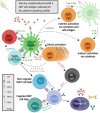Modulation of Immune Responses to Influenza A Virus Vaccines by Natural Killer T Cells
- PMID: 33193296
- PMCID: PMC7606973
- DOI: 10.3389/fimmu.2020.02172
Modulation of Immune Responses to Influenza A Virus Vaccines by Natural Killer T Cells
Abstract
Influenza A viruses (IAVs) circulate widely among different mammalian and avian hosts and sometimes give rise to zoonotic infections. Vaccination is a mainstay of IAV prevention and control. However, the efficacy of IAV vaccines is often suboptimal because of insufficient cross-protection among different IAV genotypes and subtypes as well as the inability to keep up with the rapid molecular evolution of IAV strains. Much attention is focused on improving IAV vaccine efficiency using adjuvants, which are substances that can modulate and enhance immune responses to co-administered antigens. The current review is focused on a non-traditional approach of adjuvanting IAV vaccines by therapeutically targeting the immunomodulatory functions of a rare population of innate-like T lymphocytes called invariant natural killer T (iNKT) cells. These cells bridge the innate and adaptive immune systems and are capable of stimulating a wide array of immune cells that enhance vaccine-mediated immune responses. Here we discuss the factors that influence the adjuvant effects of iNKT cells for influenza vaccines as well as the obstacles that must be overcome before this novel adjuvant approach can be considered for human or veterinary use.
Keywords: adjuvant; immune modulation; influenza A virus; natural killer T (NKT) cells; vaccines.
Copyright © 2020 Driver, de Carvalho Madrid, Gu, Artiaga and Richt.
Figures

Similar articles
-
Harnessing Invariant NKT Cells to Improve Influenza Vaccines: A Pig Perspective.Int J Mol Sci. 2017 Dec 27;19(1):68. doi: 10.3390/ijms19010068. Int J Mol Sci. 2017. PMID: 29280974 Free PMC article. Review.
-
Adjuvant effects of invariant NKT cell ligand potentiates the innate and adaptive immunity to an inactivated H1N1 swine influenza virus vaccine in pigs.Vet Microbiol. 2016 Apr 15;186:157-63. doi: 10.1016/j.vetmic.2016.02.028. Epub 2016 Mar 2. Vet Microbiol. 2016. PMID: 27016770
-
Augmenting Influenza-Specific T Cell Memory Generation with a Natural Killer T Cell-Dependent Glycolipid-Peptide Vaccine.ACS Chem Biol. 2017 Nov 17;12(11):2898-2905. doi: 10.1021/acschembio.7b00845. Epub 2017 Oct 27. ACS Chem Biol. 2017. PMID: 29043774
-
Unaltered influenza disease outcomes in swine prophylactically treated with α-galactosylceramide.Dev Comp Immunol. 2021 Jan;114:103843. doi: 10.1016/j.dci.2020.103843. Epub 2020 Aug 29. Dev Comp Immunol. 2021. PMID: 32871161 Free PMC article.
-
Innovative Mucosal Vaccine Formulations Against Influenza A Virus Infections.Front Immunol. 2019 Jul 17;10:1605. doi: 10.3389/fimmu.2019.01605. eCollection 2019. Front Immunol. 2019. PMID: 31379823 Free PMC article. Review.
Cited by
-
Identification of Novel Modalities Through Bibliometric Analysis for Timely Development of Regulatory Guidance: A Case Study of T Cell Immunity.Front Med (Lausanne). 2021 Oct 11;8:756870. doi: 10.3389/fmed.2021.756870. eCollection 2021. Front Med (Lausanne). 2021. PMID: 34708061 Free PMC article.
-
Invariant natural killer T cells in lung diseases.Exp Mol Med. 2023 Sep;55(9):1885-1894. doi: 10.1038/s12276-023-01024-x. Epub 2023 Sep 11. Exp Mol Med. 2023. PMID: 37696892 Free PMC article. Review.
-
Role of NKT Cells during Viral Infection and the Development of NKT Cell-Based Nanovaccines.Vaccines (Basel). 2021 Aug 26;9(9):949. doi: 10.3390/vaccines9090949. Vaccines (Basel). 2021. PMID: 34579186 Free PMC article. Review.
-
Analysis of the Long-Term Impact on Cellular Immunity in COVID-19-Recovered Individuals Reveals a Profound NKT Cell Impairment.mBio. 2021 Apr 27;12(2):e00085-21. doi: 10.1128/mBio.00085-21. mBio. 2021. PMID: 33906918 Free PMC article.
-
Single-Cell Antigen Receptor Sequencing in Pigs with Influenza.bioRxiv [Preprint]. 2024 Oct 15:2024.10.13.617920. doi: 10.1101/2024.10.13.617920. bioRxiv. 2024. PMID: 39464079 Free PMC article. Preprint.
References
Publication types
MeSH terms
Substances
Grants and funding
LinkOut - more resources
Full Text Sources
Medical

